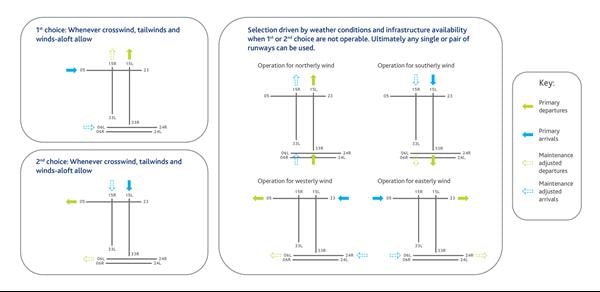Following the spring 2018 consultation on the Six Ideas, the GTAA began a one-year trial of an updated Preferential Runway System (Idea 6). The trial was scheduled for February 27, 2020 to February 26, 2021. Based on resident feedback, the trial was extended into 2022 to test the system under higher, non-pandemic, traffic volumes.
During trial, we reported on the overall adherence and usage of the updated system and invited resident feedback on the quality and clarity of the Nighttime Preferential Runway system usage reports. As traffic started to increase in late 2021, adherence to the system remained above 90 per cent. This confirmed the consistent operational success of the system under varying weather, maintenance, seasonal and traffic level conditions.
All feedback was included as part of our application to Transport Canada to formalize the trial as a permanent procedure of the GTAA’s Noise Management Program.
View the full Amended Preferential Trial Request that was submitted to Transport Canada here.
Nighttime Preferential Runway System usage reports
Usage Report – July to September 2023 (Q3 2023)
Usage Report – April to June 2023 (Q2 2023)
Usage Report – January to March 2023 (Q1 2023)
Usage Report – October to December 2022 (Q4 2022)
Usage Report – July to September 2022 (Q3 2022)
Usage Report – April to June 2022 (Q2 2022)
Usage Report – January to March 2022 (Q1 2022)
Usage Report – November to December 2021 (Q4 2021)
Usage Report – July to September 2021 (Q3 2021)
Usage Report – April to June 2021 (Q2 2021)
Usage Report – January to March 2021 (Q1 2021)
Usage Report – February 27, 2020 to February 26, 2021
Background on Nighttime Preferential Runway System Trial
Pearson recognizes that airports have impacts, such as noise, on local communities. While airport noise can’t be eliminated entirely, we believe that continuous improvements should be studied, discussed and implemented with our neighbours. Through our Noise Management Action Plan, we worked with our partners and the community to manage noise impacts. One example is our three-year collaboration with NAV CANADA on the Six Ideas: A Quieter Operations Roadmap.
We operate around the clock, seven days a week. We know that nighttime noise can be particularly bothersome for some. Between midnight and 6:30 am, we prioritize the use of runways to minimize the number of residents overflown. This is called our Nighttime Preferential Runway System. Preferential runway systems are common to many major international airports that operate at night.
We have had a Nighttime Preferential Runway System since the 1970s. However, the communities around the airport have changed over the last five decades—and the airport has, too. That’s why we undertook technical analysis and consultation as part of the Six Ideas to update the Nighttime Preferential Runway System so it better reflects today’s environment. Community feedback indicated support for trialing the proposed new Preferential Runway System to test adherence levels in real world conditions.
Combined with NAV CANADA’s new nighttime arrival and nighttime departure routes (implemented in November of 2018), our updated Nighttime Preferential Runway System reduces the number of residents overflown at night, and will also be a system that is more predictable and understandable to residents. It enables more consistent use of runways identified as the preferential runway as it now provides for into the wind and maintenance contingency runways. This means better guidance for Air Traffic controllers in various circumstances.
Updated Nighttime Preferential Runway System

The Nighttime Preferential Runway System outlines the preferred runways to use. However, non-preferential runways may be used when required by weather, wind, runway availability, or operational requirements, such as runway maintenance.
Trial details
DURATION: Began February 27, 2020 and was extended beyond done year to February 28, 2022.
TIMES: Every night, midnight to 6:30 am
The trial tested usage of the updated system across multiple weather conditions, as well as during runway construction season and winter operations.
We reported on the usage of the updated Nighttime Preferential Runway system throughout the trial.
The pilot was scheduled for February 27, 2020 to February 26, 2021. Based on resident feedback, the trial was extended into 2022 to test the system under higher, non-pandemic, traffic volumes.
Throughout the trial, we reported on the overall adherence and usage of the updated system and invited resident feedback on the quality and clarity of the Nighttime Preferential Runway system usage reports.
As traffic started to increase in late 2021, adherence to the system remained above 90 per cent. This confirms the consistent operational success of the system under varying weather, maintenance, seasonal and traffic level conditions.
All feedback received was included as part of our application to Transport Canada to formalize the trial as a permanent procedure of the GTAA’s Noise Management Program.For more detail on how your neighbourhood may experience the updated Nighttime Preferential Runway System, please visit the Six Ideas Preferential Runway System Review technical analysis webpage.
